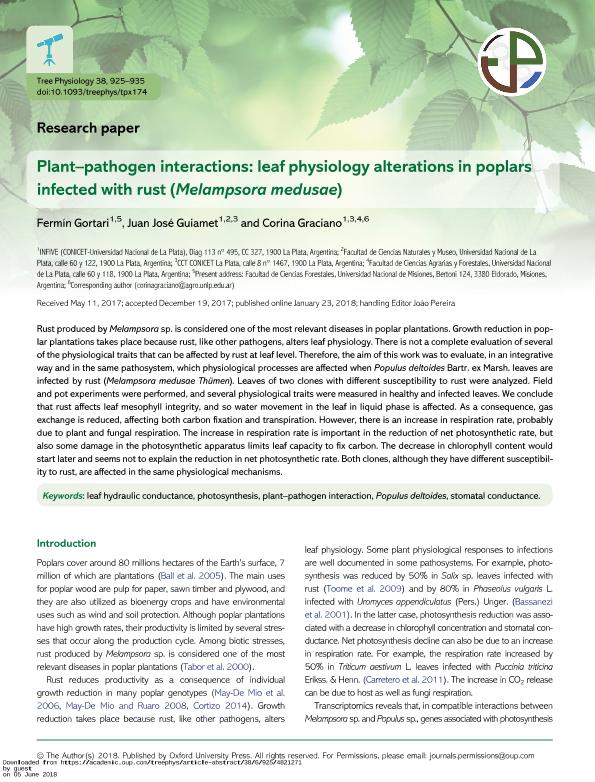Mostrar el registro sencillo del ítem
dc.contributor.author
Gortari, Fermin

dc.contributor.author
Guiamet, Juan José

dc.contributor.author
Graciano, Corina

dc.date.available
2020-01-06T20:37:17Z
dc.date.issued
2018-06
dc.identifier.citation
Gortari, Fermin; Guiamet, Juan José; Graciano, Corina; Plant–pathogen interactions: Leaf physiology alterations in poplars infected with rust (Melampsora medusae); Oxford University Press; Tree Physiology; 38; 6; 6-2018; 925-935
dc.identifier.issn
0829-318X
dc.identifier.uri
http://hdl.handle.net/11336/93711
dc.description.abstract
Rust produced by Melampsora sp. is considered one of the most relevant diseases in poplar plantations. Growth reduction in poplar plantations takes place because rust, like other pathogens, alters leaf physiology. There is not a complete evaluation of several of the physiological traits that can be affected by rust at leaf level. Therefore, the aim of this work was to evaluate, in an integrative way and in the same pathosystem, which physiological processes are affected when Populus deltoides Bartr. ex Marsh. leaves are infected by rust (Melampsora medusae Thümen). Leaves of two clones with different susceptibility to rust were analyzed. Field and pot experiments were performed, and several physiological traits were measured in healthy and infected leaves. We conclude that rust affects leaf mesophyll integrity, and so water movement in the leaf in liquid phase is affected. As a consequence, gas exchange is reduced, affecting both carbon fixation and transpiration. However, there is an increase in respiration rate, probably due to plant and fungal respiration. The increase in respiration rate is important in the reduction of net photosynthetic rate, but also some damage in the photosynthetic apparatus limits leaf capacity to fix carbon. The decrease in chlorophyll content would start later and seems not to explain the reduction in net photosynthetic rate. Both clones, although they have different susceptibility to rust, are affected in the same physiological mechanisms.
dc.format
application/pdf
dc.language.iso
eng
dc.publisher
Oxford University Press

dc.rights
info:eu-repo/semantics/openAccess
dc.rights.uri
https://creativecommons.org/licenses/by-nc-sa/2.5/ar/
dc.subject
LEAF HYDRAULIC CONDUCTANCE
dc.subject
PHOTOSYNTHESIS
dc.subject
PLANT–PATHOGEN INTERACTION
dc.subject
POPULUS DELTOIDES
dc.subject
STOMATAL CONDUCTANCE
dc.subject.classification
Ciencias de las Plantas, Botánica

dc.subject.classification
Ciencias Biológicas

dc.subject.classification
CIENCIAS NATURALES Y EXACTAS

dc.title
Plant–pathogen interactions: Leaf physiology alterations in poplars infected with rust (Melampsora medusae)
dc.type
info:eu-repo/semantics/article
dc.type
info:ar-repo/semantics/artículo
dc.type
info:eu-repo/semantics/publishedVersion
dc.date.updated
2019-10-18T18:33:10Z
dc.journal.volume
38
dc.journal.number
6
dc.journal.pagination
925-935
dc.journal.pais
Reino Unido

dc.journal.ciudad
Oxford
dc.description.fil
Fil: Gortari, Fermin. Consejo Nacional de Investigaciones Científicas y Técnicas. Centro Científico Tecnológico Conicet - La Plata. Instituto de Fisiología Vegetal. Universidad Nacional de La Plata. Facultad de Ciencias Naturales y Museo. Instituto de Fisiología Vegetal; Argentina. Universidad Nacional de Misiones. Facultad de Ciencias Forestales; Argentina
dc.description.fil
Fil: Guiamet, Juan José. Consejo Nacional de Investigaciones Científicas y Técnicas. Centro Científico Tecnológico Conicet - La Plata. Instituto de Fisiología Vegetal. Universidad Nacional de La Plata. Facultad de Ciencias Naturales y Museo. Instituto de Fisiología Vegetal; Argentina
dc.description.fil
Fil: Graciano, Corina. Consejo Nacional de Investigaciones Científicas y Técnicas. Centro Científico Tecnológico Conicet - La Plata. Instituto de Fisiología Vegetal. Universidad Nacional de La Plata. Facultad de Ciencias Naturales y Museo. Instituto de Fisiología Vegetal; Argentina. Universidad Nacional de Misiones. Facultad de Ciencias Forestales; Argentina
dc.journal.title
Tree Physiology

dc.relation.alternativeid
info:eu-repo/semantics/altIdentifier/url/https://academic.oup.com/treephys/article/38/6/925/4821271
dc.relation.alternativeid
info:eu-repo/semantics/altIdentifier/doi/https://doi.org/10.1093/treephys/tpx174
dc.relation.alternativeid
info:eu-repo/semantics/altIdentifier/url/https://watermark.silverchair.com/tpx174.pdf?token=AQECAHi208BE49Ooan9kkhW_Ercy7Dm3ZL_9Cf3qfKAc485ysgAAAmQwggJgBgkqhkiG9w0BBwagggJRMIICTQIBADCCAkYGCSqGSIb3DQEHATAeBglghkgBZQMEAS4wEQQMzPaoCAEfPqttBcsWAgEQgIICF44c_taE-bfduvkCpMsI2Z6BCekrMkLB7tta1G5EmJOc_pvhZKhI3v9Oj736KGMP8FhpJkVirrHHnhng635wle-ps6exsE_sDIQ-jgc3Csu6cf2iXi7rTGoTtxEvBDWRxVtyWeR21ggKqTb0MpBpBHSNFh76GoAhlsFHQeABx8LxLgwvnBBltTgFncs7CrDIXgdzJee9ahaSquErmnjSBPcUqV1d8KED4vPdF7ZUiL_9nv2oG_qFHXdAdx5QdB59l15goxASty0peM2PDLFyrhIbytSA-Un1pLcigefoiGyp-p1FP9Z5MSWliA1rsHScD2138OuhkjwFmtCUQ_narl5NxPcXZr1aATsM3TS7ZTed6JqcIIcElPBvcxuwo4lMMMnZceSUl10rfWVbDIWgdnUnLag6SEKvcTQ43YPzPGtKK1VMSfHtRqZgBAosV4B2zz0ENSKuAb9RRFnKzmcBTG67fWYdlR7HAcJw2t7i9ZQ0YeNBZxMrH0qGg-fJxMB1Y7_AGhRV_uSuGnzdt5d9YpArtc5Q9TsK47E3v_T_ysFvewmu-PDqScWop6cDiSiSrtjkdHjcVE5BdYvAmOrup_u5-usIxXaWafWpanvEvIWNzHIpJlZkRpeojaRNWcceHdJk00tqvgahxmk_PtxbOtxc3-5A29iV7GudyjvpJbUbmtOdWhhAb_zvPy8pZImZFGcOvkSfMFY
Archivos asociados
